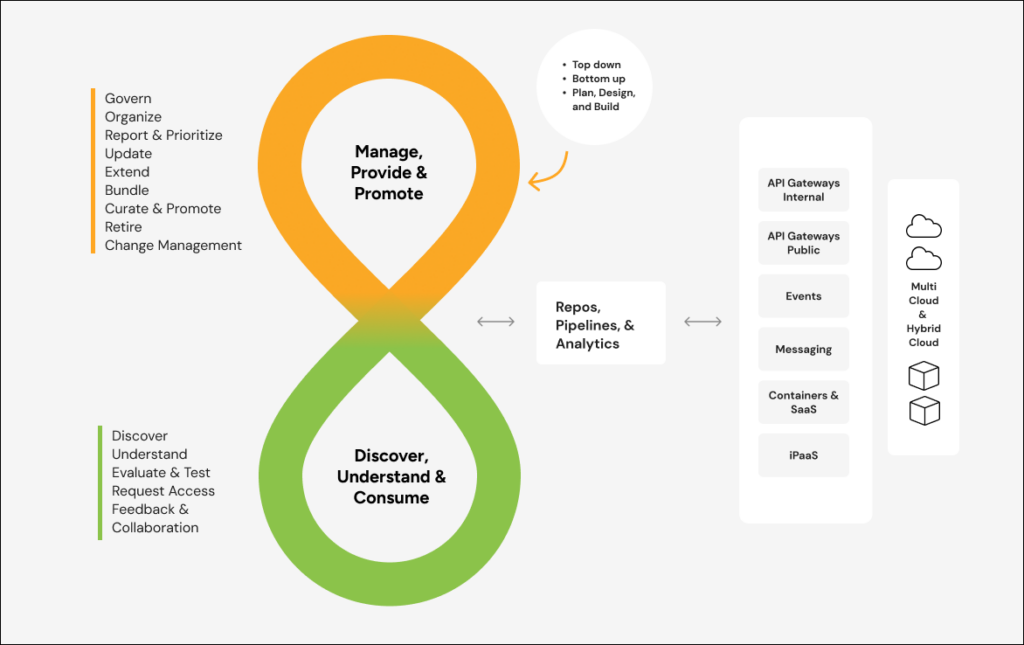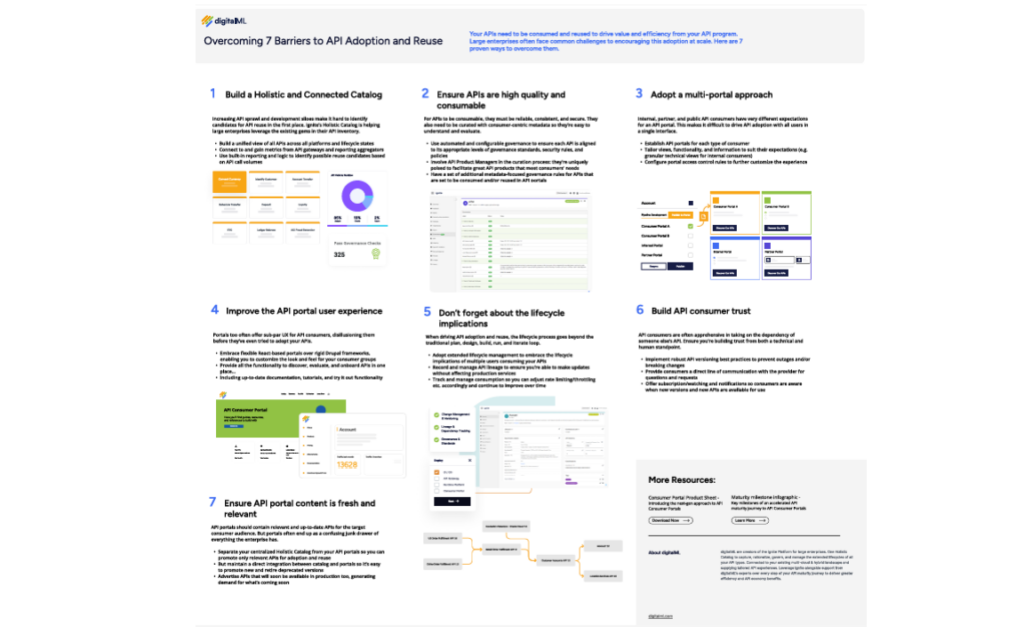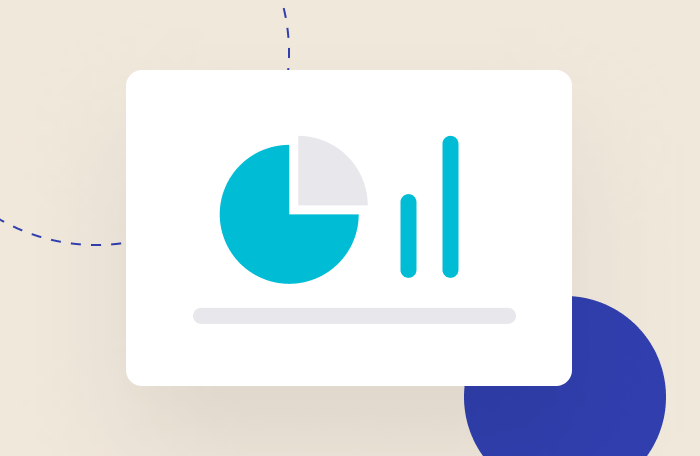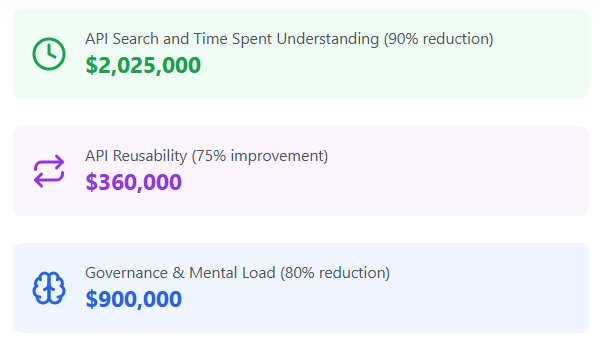Is your API lifecycle management process really supporting API reuse?
API reuse is once again becoming a priority for enterprises aiming to enhance efficiency and achieve significant cost savings across API programs. Reusable APIs are most often those exposing key business capabilities that can be used across teams, platforms and/or products.
Effective reuse brings a reduction in API duplication, streamlines operations, and enables you to focus resources on innovation. However, achieving this reuse can be challenging due to various barriers such as inconsistent and incomplete APIs, poor consumer experiences, and overly complex API programs. In this article we’ll discuss how good API lifecycle management helps overcome these barriers, by extending the lifecycle beyond the gateway and the traditional plan, design, build loop.
The importance of API reuse in enterprises
API reuse offers numerous benefits for large enterprises, including increased efficiency and reduced costs. Ultimately, increasing reuse results in faster development cycles and more consistent, reliable services for your customers and partners. API reuse allows you to focus on adding value through new features and improvements, rather than reinventing the wheel.
And, as enterprises’ API portfolios grow, so does API duplication and its associated cost and overhead. Reusing functionality exposed by APIs across teams, lines of business, and the wider API ecosystem is one of the most effective ways to minimize duplication.
Enterprises are trying to build reusability in when developing new APIs, as well as wanting to identify existing APIs that may be suitable for further consumption with different audiences.
Common API reuse barriers
But enabling API reuse can seem challenging, thanks to common barriers including:
- Not all APIs are reusable: with enterprises having 100s-1000s of APIs in their portfolio, the reality is that not all of these will be suitable for reuse, but they need to be tracked and managed effectively alongside the reusable gems.
- API program complexity: making it hard to identify reuse candidates from the existing API inventory, particularly if your organization is working with multiple API gateways across multi- and hybrid cloud.
- Inconsistent and incomplete APIs: especially as a result of a lack of, or manual, API governance and standards. Inconsistent naming conventions, documentation gaps, and missing functionalities can deter consumers from reusing existing APIs.
- Poor API consumer experience: across the consumer interface itself, inconsistent APIs as mentioned above, and by a lack of connection between the API consumer and the provider when it comes to providing feedback, requesting changes, etc.
- Reusable APIs can be hard for consumers to find and evaluate: Your consuming developers should be able to easily discover reusable APIs, decide if they meet their use case, evaluate if they want to take on the dependency, and get approval for the API to start the ongoing connection with the API provider.
With reuse comes an Extended Lifecycle to manage
If you’re trying to prioritize API reuse and reduce duplication, you’ve likely realized it’s no mean feat. Reuse in large enterprises is complex. You may have different business and technical implications of different types of reuse; such as an external customer reusing an internal API vs internal users reusing APIs across different gateways. You may have different goals and thresholds of API reuse, which will change as you evolve.
Good API lifecycle management can help tackle this complexity and overcome common barriers to reuse.
Baking in and automating governance, security, and standardization so that it’s just part of the process without added friction helps create more reusable APIs by design. Providing secure, quality, and compete artifacts encourages developers and other consumers to leverage existing APIs over building new.
However, a traditional approach to lifecycle management that incorporates the plan-design-build loop only is insufficient for large enterprises trying to enable reuse at scale.
Reuse introduces complexities such as managing multiple consumers, supporting various versions across different environments, and ensuring consistency and reliability across different types of reuse. Here are some capability areas to help extend your API lifecycle management process to drive effective reuse.

7 API Lifecycle Management Areas to extend and optimize for API reuse
1. Identifying reuse candidates
When you’re working with a large API inventory spread across different platforms and environments, it can be challenging to find good candidates for reuse. Utilizing one centralized API catalog which is tied to runtimes and reporting aggregators like Splunk can help you identify APIs already being used which might be appropriate to use elsewhere.
2. Automated API governance supporting API curation
API governance is traditionally thought of as incorporating API design best practices during API development, often manually.
But once the API has been created, you can extend your governance model to add extra business-focused rules to ensure it’s surrounded with consumer-centric metadata and documentation. This helps the API to be easily discoverable and understandable by consumers when you expose it to your API portal(s). This is what we call API curation, and it works even better if the process involves API Product Managers who have a unique understanding of your end-consumers.
Automating manual and error prone tasks in your API governance framework can help too, making sure you’re offering the reliable experiences that help build API consumer trust and encourages reuse.
3. Creating a connection between the API provider and API consumer
Building trust in your API consumer audience is a key factor in encouraging reuse. Creating a direct connection between the API provider and consumer is one way to help build this. Consumers should be able to provide feedback on APIs, ask questions, request changes and influence the API’s roadmap. Regular communication and feedback loops enable continuous improvement and better alignment with consumer expectations, building trust for API reuse.
4. API versioning and change management
Consumers will inevitably want updates and new features for APIs. This needs to be managed properly to maintain smooth user experiences.
A robust API versioning strategy which provides visibility and captures API complexity and dependencies is key here. It might be helpful to nest all your versions under a centralized Design, for example.
It’s also important to enable API providers to perform impact analyses and follow change management best practices before updates are made. This helps minimize breaks and outages and further helps build that API consumer trust just discussed.
5. Reliable redeploy
Once your API providers have made their requested changes, it’s also important to ensure they’re able to deploy these new versions (or redeploy existing versions) in a consistent manner.
Automating deployment to your pipelines is helpful here, especially if you can generate consistent artifacts such as SDKs, code, contract, and configurations directly from the API design and specification.
6. Communicate change
When new API versions are in production, your API consumers need to be made aware directly in their consumer interfaces/API portals so they can integrate the new version and continue reusing your API.
A best practice here is to enable the API provider to send out notifications to your API portal(s) directly from where they’re working (most likely the API catalog).
7. Tracking consumption and reuse
Tracking the reuse rate of APIs over time is essential for continuous improvement. By monitoring consumption patterns, you can prioritize and enhance your APIs and reuse strategy, accelerating overall API maturity and reaping more efficiency benefits. A unified API metrics and analytics approach provide valuable insights into API performance and reuse trends.
ignite Can Help
Our ignite Platform provides the key capabilities to extend your API lifecycle management process to support effective API reuse and its associated benefits. These include:
- A connected Holistic Catalog which captures your entire API inventory across all runtimes and lifecycle states. The catalog connects to all your API gateways and reporting aggregators and applies built in logic to help you identify API curation and reuse candidates, while managing APIs that are not (and may never be) reusable, too.
- Automated, configurable, and democratized API governance and curation.
- API Consumer Portals that are powered by the catalog, with notification and collaboration functionality to create and maintain a direct connection between the API provider and consumer.
- Robust API versioning, API lineage and complexity management.
- Connection and reliable deploy to all your repos, pipelines, and gateways.
- API consumption and reuse tracking and metrics, and API maturity progression reports.
Conclusion
In conclusion, enhancing your API lifecycle management process to support API reuse requires extending traditional practices. By focusing on identifying reuse candidates, implementing robust governance, fostering direct connections between providers and consumers, managing versions effectively, ensuring reliable redeployment, communicating changes, and tracking consumption, organizations can drive efficient and cost-effective API reuse. ignite’s lifecycle management solutions provide the necessary tools to achieve these goals and support your API reuse strategy.
You can also learn more about overcoming common barriers to API reuse with our free poster here:

Differentiate Your Digital Enterprise Now
Learn how it can help your enterprise accelerate digital transformation



